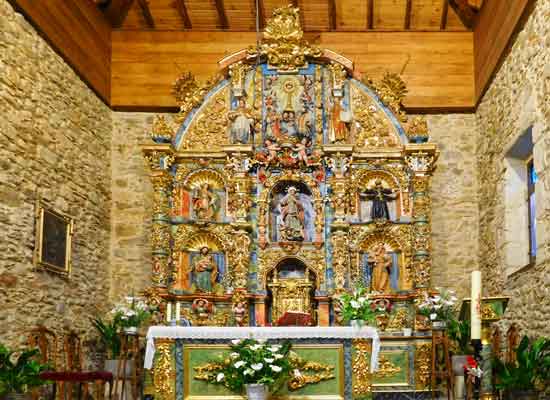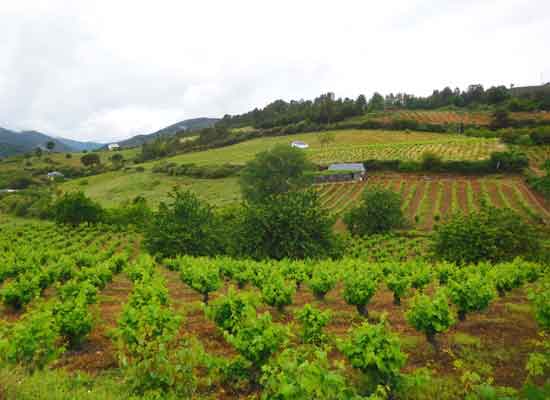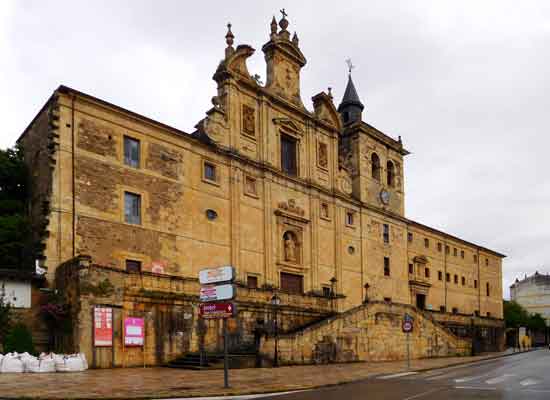Step by step along The Way of Saint James
From Ponferrada to Villafranca del Bierzo
4 June 2018
Stage 25 – Km. 25

Today's route, which follows a fairly flat path, lies between two high-mountain stages: yesterday's, where the maximum altitude was around 1,500 metres near the Cruz de Hierro, and tomorrow’s, which will reach its highest point at O Cebreiro, approximately 1,300 metres above sea level.
However, the scenery along today’s route is not flat and desolate like that of the “mesetas.” Instead, it is a pleasant area of gentle green hills with mild and manageable ups and downs.
We will cross the heart of Bierzo, a Spanish region known for producing high-quality products such as wines, apples, and chestnuts.
The climate here is relatively mild, thanks to the influence of the Atlantic Ocean.
My legs feel much better, and the pain in my shins is now just a bad memory. Nevertheless, I remain cautious and careful not to strain my still-recovering joints too much.
As I get closer to completing The Way, I do not want to risk jeopardising the outcome. For this reason, I will continue walking without my backpack for a few more days.
Rocco and Giovanna, for reasons different from mine, also decide to tackle this stage without the heavy burden on their shoulders.
Following the advice of a hospitalero, we all leave our backpacks at the hostel entrance. Later, they will be picked up by the courier and delivered to the destination we have chosen.
Just before half-past six, we leave the comfortable hostel in Ponferrada.
It is still dark, and the silence is absolute; only a light drizzle accompanies us as we cross the large square between the hostel and the bar opposite.
After breakfast, expecting a rainy day, we gear up with ponchos and gaiters before setting off.
At 6:50, we begin this twenty-fifth stage on the road to Santiago de Compostela.
As soon as we step out of the bar, it stops raining, making the gear we just put on completely unnecessary.
Moreover, the sky clears up slightly, hinting at a beautiful day ahead.
To leave Ponferrada, we first walk through the historic centre and then cross the famous bridge over the río Sil. We join the long line of pilgrims who, over the past millennium, have crossed it on their way to Santiago de Compostela.
We continue along the internal avenue of a city park that runs alongside the river.
The exit from the city is marked by passing an old power station, now disused and transformed into the Museum of Energy.
After covering the first five kilometres and while crossing the small village of Fuentes Nuevas, some pilgrims inform us that there has been an issue with the backpacks we left at the hostel.
As the details are unclear, I call the hostel to get precise information. They tell me the backpacks are no longer where we left them, and, at the same time, they cannot confirm whether the courier has collected them.
I hang up and immediately call the courier.
He, who has already passed through Ponferrada, assures me he did not pick up our backpacks.
For about fifteen minutes, I make a series of calls to both the hostel and the transporter. In the end, neither can give me any clear information, and both prove uncooperative and unwilling to resolve the problem.
– It would be unfortunate to arrive at the hostel tonight and not find the few essentials we need for living The Way. –
At this point, we have no choice but to go back and personally look for the backpacks.
Obviously, walking back is out of the question due to time constraints, so the only solution is to take a taxi.
Rocco and I go, while Giovanna, unconcerned about her backpack and confident it will be at the hostel this evening, resumes her journey along The Way.
I get teary-eyed as I step into the car. I have been walking for almost a month, and during this time, I have never used motorised transport, not even on the toughest days when I carried on despite intense leg pain.
Resorting to a taxi feels like a stain on my journey.
– Almost a defeat! –
We return to Ponferrada in no time.
Before heading to the hostel, I have the idea to check the bar where we collected the backpacks delivered by the courier yesterday.
The hunch proves right—almost “elementary,” as Sherlock Holmes would say to Dr. Watson.
The backpacks are indeed in the storeroom, and no one knows who moved them from the hostel to the bar. At this point, however, it doesn’t matter.
The only certainty is that they would have remained there until tomorrow morning, and we would have been without our belongings tonight.
We take the backpacks and carry them with us.
On the way back, we arrange with the taxi driver to have them delivered directly to tonight’s hostel.
Rocco, considering the time lost resolving this issue, suggests we continue the journey from the next village.
I disagree and ask the driver to drop me off at Fuentes Nuevas, precisely where I got into the car an hour earlier.
– Not a metre further! –
This way, Rocco and I part ways, agreeing to meet again later in the day at the end of the stage.
As good friends, we have also retrieved Giovanna’s backpack, and we’ll meet her at the hostel as well.

It is almost ten o’clock when I resume walking.
From here, there are still sixteen kilometres to go to Villafranca del Bierzo.
Before leaving Fuentes Nuevas, I visit the iglesia de Nuestra Señora de la Asunción, a charming 18th-century church that was completely restored a few years ago.
Inside, the exposed stone walls create a warm and welcoming atmosphere. Three beautiful polychrome retablos offer a true triumph of Baroque art, including a statue of Saint James the Pilgrim.
Looking up, one can admire a lovely fresco of the Last Supper and a beamed ceiling.
The visit to the small church has lifted my spirits, which had sunk earlier this morning due to the search for the backpack—and especially because I had to use a car.
Compared to me, my friends are all further ahead, so I will complete the rest of the stage alone.
It is nice to share The Way with others, but it is also a great pleasure to be alone with my thoughts and use these moments to look beyond what my eyes can see—deep into my soul.
In a way, I see this day as a “holiday,” so I decide to take it easy without worrying about how long it will take to reach my destination.
It is a pity that the weather did not improve as expected this morning.
It drizzles intermittently, and even when it stops, I keep my poncho on—it is neither quick nor practical to take it off and put it back on.
From one village to another, the beautiful landscape I walk through changes frequently, alternating different scenes: golden fields of wheat almost ready for harvest; green rows of vines overflowing with leaves, soon to yield precious nectar; red meadows filled with tall poppies, which always bring me a special joy.
Despite the dark, rainy sky, these natural backdrops surrounding the path make my journey along The Way unique and unforgettable.
– I find beauty even in the contrast between the vibrant colours of the landscape and the dark grey sky. –
After passing through Camponaraya and crossing the bridge over the autovía de Noroeste, vineyards become increasingly frequent.
The widespread presence of these cultivated fields highlights the Bierzo region’s strong vocation for producing high-quality wine.
It is almost noon when I reach Cacabelos.
The town has about five thousand inhabitants and is noticeably larger and livelier than the small villages often encountered along The Way.
I see the iglesia de San Roque (Saint Roch), built in the 16th century. After a period of plague, the church was dedicated to the saint as a protector against the deadly epidemic.
I stop for a few minutes to visit it.
Inside, there are pasos—large floats with statues depicting scenes of the Passion, carried in processions during Holy Week.
About eight kilometres remain to complete the stage. Although I need to make up for the time lost this morning due to the missing backpack, I decide to take a break for a quick meal.
Having no food supplies, I enter a large supermarket in the centre of town.
Among the women doing their shopping, I feel a bit like a “ghostbuster” because of my appearance: I am wearing gaiters and a black poncho that, covering my backpack, makes me look like I have a huge hump.
Since it is still drizzling and I only plan to stay inside for a few minutes, I decide not to remove my rain gear to save time.
Once my hunger is satisfied, I set off again.
Before leaving Cacabelos, I take a look—only from the outside—at the iglesia de Santa María, a Romanesque church almost entirely rebuilt in the 16th century.
Its simple façade features a neo-Romanesque bell tower, erected in the early 20th century.
A little further on, I leave the town by crossing the puente Mayor over the río Cúa.
The original bridge was built during Roman times and later replaced, between the 16th and 18th centuries, with the current structure featuring six arches.
After walking a few more minutes, I pass the sanctuary de la Quinta Angustia, an 18th-century structure with an imposing Baroque façade. Surrounding the sacred building is the municipal hostel of Cacabelos.

Half a kilometre after the small village of Pieros, there is the option to take an alternative route.
This detour passes through Valtuille de Arriba but adds about two kilometres to the stage.
Continuing along the French Way, however, offers a shorter path through fields still characterised by long rows of vines.
I choose this latter route, and the landscape just described accompanies me to the end of the stage.
It is 14:05 when I arrive in Villafranca del Bierzo.
Entering the town, even before reaching the main centre, I encounter the Romanesque iglesia de Santiago Apóstol.
The austere exterior of the church features some particularly beautiful details, especially the so-called puerta del Perdón.
The arches surrounding this door are richly decorated with floral, geometric, and biblical motifs.
The door is opened during the Jubilee of Saint James and is named “Door of Forgiveness” because, in the past, indulgences were granted here to pilgrims who, due to health reasons, could not continue The Way to Santiago de Compostela.
Just as I walk the last few hundred metres of the stage, I receive a call from Rocco. He tells me that he and Giovanna have been at the hostel for quite some time and that, once again, they kindly reserved a spot for me.

Shortly afterward, I reach the Albergue y Hospedería San Nicolás el Real.
The hostel is located in the town centre and is part of the adjoining church of the same name.
The entire architectural complex, built in the 17th century, is an example of Jesuit Baroque.
The accommodation area consists of large dormitories as well as double and single rooms, offering a total of 150 beds.
The dormitory where we are staying is a perfectly rectangular space of enormous dimensions, both in floor area and height.
There are no bunk beds—only single beds arranged side by side in two rows.
The white sheets and the starkness of the room, devoid of any other furniture and with completely bare walls, remind me more of a hospital than a guesthouse.
After all, we are in a monastic complex that reflects the lifestyle of the religious people who once lived here.
The room feels even more barren because, apart from me, Rocco, and Giovanna, only one other bed is occupied by a young Belgian girl.
Amandine, as she introduces herself, keeps to herself, curled up in her bed at the far end of the dormitory.
She seems rather exhausted, and I imagine that, besides fatigue, she is also suffering from blisters, given the visible bandages on her feet.
Only later, when Giovanna helps her treat the painful sores, does she join us.
Starting tomorrow, Amandine will become another companion on The Way and will stick with our group all the way to Santiago de Compostela.
Upon arriving at the hostel earlier, the first thing I did was check that my backpack had been delivered here, as arranged this morning with the taxi driver who helped us retrieve it in Ponferrada.
Considering what happened today, and despite tomorrow's stage involving a challenging ascent, I have decided to carry my backpack with me.
By now, I feel fit, and I should no longer have any physical problems. – I hope! –
Around six o'clock in the evening, after a brief but intense rain shower, we head out to explore the town centre.
Villafranca del Bierzo, situated at an altitude of 540 metres, is the last notable town in Castilla y León. From here, the border with the province of Galicia is not far.
The town has about 3,500 inhabitants and, in addition to being a significant stop along the French Way, it is also a popular tourist destination.
The numerous monuments in the historic centre have earned Villafranca del Bierzo recognition as a “Site of Cultural Interest.”
Leaving the hostel, we once again admire the exterior of the iglesia de San Nicolás el Real, located right next to the building where we are staying.
This time, we have the opportunity to observe it without haste, taking in every detail of its imposing façade.
At the entrance to the town, near the church dedicated to Santiago, stands the castle-palace of the Marquises of Villafranca.
Other noble residences can be admired along the calle del Agua, including the palacio de Torquemada and the casa Moresca. All these buildings are characterised by dynastic coats of arms carved into their façades.
Another monumental religious building is the colegiata de Santa María de Clunia. Built in the late Gothic style, it also features Renaissance and Baroque elements that coexist harmoniously.
Finally, we reach the plaza Diego Saavedra, where the jardines de la Alameda are located. Designed in the style of Versailles, these gardens have perfectly trimmed hedges that outline the internal paths.
In the same square stands another noble residence, the palacio de los Duques de Arganza, which features an impressive entrance staircase guarded by two large stone lions.
As is often the case during our sightseeing outings, after our cultural tour, we end the walk with a visit to a supermarket.
We buy the usual provisions for tomorrow’s breakfast and snacks for the day.
Later in the evening, we go to dinner at the Restaurante Sevilla in the plaza Mayor.
It is a charming and welcoming place, like many others in the same square.
From the “pilgrim’s menu,” priced at 11 Euros, I order: Sopa de fideos con garbanzos (noodle soup with chickpeas); Asado de ternera (roast veal); and Flan de leche (the classic dessert similar to crème caramel).
Given the cold, drizzly evening and the accumulated fatigue, after dinner, we head straight back to the hostel to sleep.
Tomorrow’s stage is expected to be quite demanding, so it is essential to regain our strength.
| © Aldo Lardizzone 2020 |  |
CREATIVE COMMONS |



